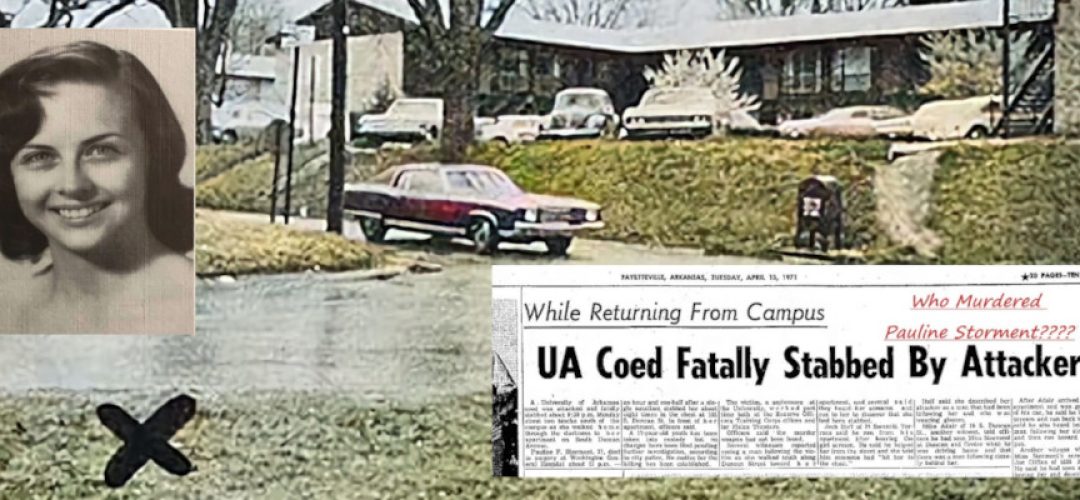For most of my life, the haunting tale of my cousin’s brutal murder has lingered in the shadows of my mind. Pauline Storment, my first cousin twice removed, was the niece of my mother’s paternal grandmother, Lela “Storment” Stacks – my great-grandmother. This macabre tragedy has gnawed at the back of my brain since childhood, but it wasn’t until my forties that a burning curiosity ignited within me, yearning to unravel the enigma surrounding her case.
Ever since the day I filed my first FOIA request, I’ve been plagued by the quintessential questions: who killed her, why, and how were they able to vanish into the night of April 12th, 1971, leaving a trail of unanswered riddles in their wake? This case has been a perplexing conundrum, to say the least.
Let’s delve into the fateful night that unfolded:
Pauline was a university student at the University of Arkansas at Fayetteville, studying Anthropology. She worked at the Malco Movie Theatre and as a secretary at the campus R.O.T.C. office through a work-study program. Around 7:30 PM, a woman named Terri Keating (Stella Terri Keating) encountered Pauline at the R.O.T.C. office. Pauline invited her to attend a black gospel concert hosted by the group Black Americans for Democracy as part of Black Emphasis week at the Union Ballroom in the Memorial Hall building, adjacent to the R.O.T.C. building.
Reflecting on the social climate of 1971 from our present-day perspective, one can’t help but wonder if a white racist might have taken offense at a white girl attending a black gospel concert – an easy conclusion to draw, but mere speculation nonetheless. The concert was scheduled to last no more than an hour, leaving Pauline ample time to attend and still squeeze in some studying at the Campus Library, as she often did well into the late hours, typically not returning home until 11 PM.
However, something or someone must have spooked Pauline at the library, prompting her to leave around 9:15 PM or 9:20 PM, only to be tragically stabbed around 9:45 PM. The author David DeKok agrees that drawing a parallel between Pauline’s murder and that of Betsy Aardsma, who was killed in a library on a college campus, based solely on their shared dark hair, is a stretch. Yet, it’s no more of a creative leap than suggesting Ted Bundy as the perpetrator, given his penchant for targeting young co-eds and his known presence in Arkansas, coupled with a witness statement from Joe Clifton, who claimed to have heard a yell for help while driving through the Summit Terrace Apartments parking lot, initially mistaking it for a drunk girl or a young lady having a good time. This raises the unsettling question: did Pauline know her killer in some capacity?
Flash forward to the investigation conducted on behalf of the Arkansas State Police between Memphis, Tennessee, and Atlanta, Georgia. Iris Fletcher, Pauline’s former roommate, revealed that Pauline had married Charles Joseph Pate on June 4th, 1944, and was deathly afraid of her ex-husband at the time of the murder. Could he have been involved? One newspaper article even suggests that Pauline went by the name “Whitney” – was she hiding from Pate? We may never know, as he passed away on June 11, 2016. However, detectives felt he was not the killer since he attended Pauline’s funeral, though the details of their questioning remain undocumented.
In the 1970s, it seemed as if killers lurked around every corner. The notorious Ed Kemper, the Co-Ed Killer of California, and the elusive Zodiac immediately come to mind. While none were explicitly linked to Arkansas, there was one man who claimed to be both the Zodiac and the Phantom Killer of Texarkana. Then there was the University of Arkansas student Henry Booker “Doodie” Tennison, who committed suicide by consuming mercury cyanide poison on November 5th, 1948, leaving behind an elaborate suicide note in which he claimed to be the Phantom Killer. Unless, of course, there’s truth to the folklore surrounding the broken 1900 stone on Senior Walk at the University of Arkansas campus, which allegedly cursed any student who stepped on it with the inability to graduate. But surely, a misstep by Pauline couldn’t have sealed her fate – that would be a premise worthy of an Eli Roth horror flick.
Without any solid leads, we’re left to ponder the theory of wrong place, wrong time. Witness accounts suggest that after walking south along Duncan Avenue from the University, Pauline was stabbed eight times upon arriving at the intersection of Duncan and Treadwell. However, one witness, Mike Adair, claimed to have seen a six-foot-tall man with messy, blondish hair combed to the side, wearing glasses and a brown sports coat, following Pauline as she walked along South Duncan, crossing Center Street. By the time Adair pulled behind his apartment building at 16 South Duncan (in the vicinity of today’s Atmosphere Apartments) and stepped out of his vehicle, he heard Pauline’s screams for help echoing through the blocks.
While I hold little hope for this case to be solved or for closure to be found, I choose to raise Pauline’s story because her memory must never be forgotten. To those who relish unsolved true crime tales, may her tragic fate ignite a fire within you to seek justice. And to those who knew and loved Pauline, may the retelling of her story offer a cathartic release, a heartfelt tribute to a life cut short by the cruelest of fates.

























